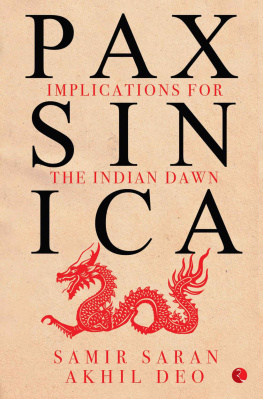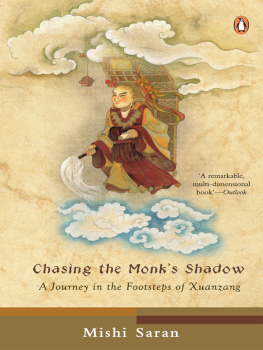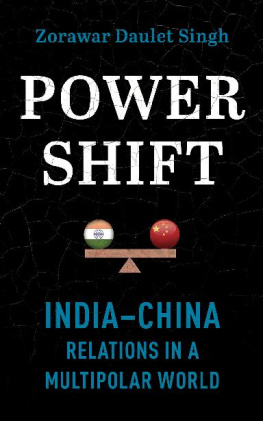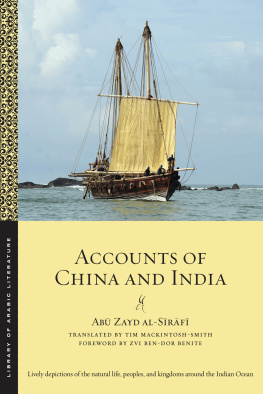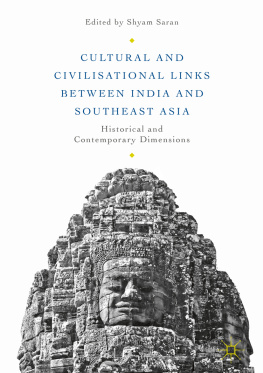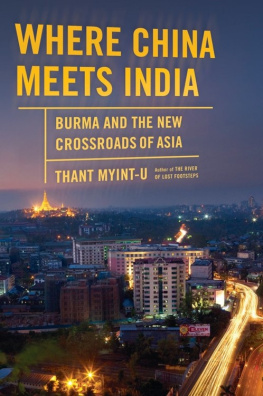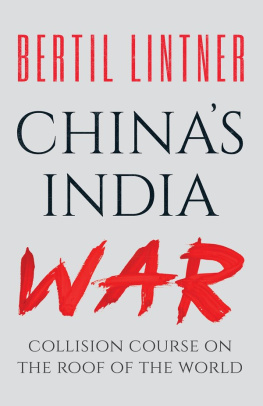Saran - How China Sees India and the World
Here you can read online Saran - How China Sees India and the World full text of the book (entire story) in english for free. Download pdf and epub, get meaning, cover and reviews about this ebook. year: 2022, genre: Politics. Description of the work, (preface) as well as reviews are available. Best literature library LitArk.com created for fans of good reading and offers a wide selection of genres:
Romance novel
Science fiction
Adventure
Detective
Science
History
Home and family
Prose
Art
Politics
Computer
Non-fiction
Religion
Business
Children
Humor
Choose a favorite category and find really read worthwhile books. Enjoy immersion in the world of imagination, feel the emotions of the characters or learn something new for yourself, make an fascinating discovery.

How China Sees India and the World: summary, description and annotation
We offer to read an annotation, description, summary or preface (depends on what the author of the book "How China Sees India and the World" wrote himself). If you haven't found the necessary information about the book — write in the comments, we will try to find it.
Saran: author's other books
Who wrote How China Sees India and the World? Find out the surname, the name of the author of the book and a list of all author's works by series.
How China Sees India and the World — read online for free the complete book (whole text) full work
Below is the text of the book, divided by pages. System saving the place of the last page read, allows you to conveniently read the book "How China Sees India and the World" online for free, without having to search again every time where you left off. Put a bookmark, and you can go to the page where you finished reading at any time.
Font size:
Interval:
Bookmark:
How China Sees India and the World

I would like to dedicate this book to my wife Anita, a most supportive and indulgent companion, and to my children Nakul and Indrani, their spouses Geertje and Seth, and my grandchildren Sami and Zev, all of whom continue to be my dedicated team of cheerleaders.
Introduction
Soon after I joined the Indian Foreign Service in 1970, I was told I would be sent to Hong Kong to learn Mandarin, the standard Chinese spoken in Beijing. I was not particularly enthused. I knew little about China and even less about the language of that country. But I did know that China was in the throes of the Great Proletarian Cultural Revolution that had unleashed widespread political violence in the country. Our own embassy in Beijing had been attacked, as had the British embassy. Indias relations with China had remained frosty since the unfortunate border war of 1962. I was apprehensive about being thrown into this maelstrom of conflict once I had concluded my language studies.
My entire outlook towards China and the Chinese changed when I arrived in Hong Kong in 1971 and took up the study of Mandarin at the British Ministry of Defence School. My Chinese teachers were among the best, but more than their professional skills, what impressed me were their patience, consideration, and, over time, even affection. I learnt more Chinese from them outside the classroom than inside, spending weekends with them, going out to restaurants or just sightseeing in Hong Kong in their company. Learning Mandarin opened a whole new and fascinating world for me. I was coming face to face with a civilization with a long and varied history, a philosophical and cultural heritage of enormous richness, and a view of the world quite distinct and indeed different from others. There were elements that were recognizably Asian for example, the central role of family and kinship ties. But some were uniquely Chinese, like the language itself, made up of ideograms and without an alphabet. I discovered that China had a vast, almost inexhaustible store of written and documented history going back 3,500 years, with precise dating of events that occurred a long time ago. India had nothing comparable.
I spent a total of six years serving in China, first during the last phase of the Cultural Revolution (197477) and then during the early years of economic reform and liberalization (198386). On my first posting, I witnessed a China that had closed its doors on the world and embraced a drab and austere life while creating a socialist paradise, rejecting its own rich culture and traditions as obstacles to its modernization. In the words of Chinas leader Mao Zedong, who wanted to wipe the slate clean so that a new China could be built:
On a blank sheet of paper free of any mark, the freshest and most beautiful characters can be written; the freshest and most beautiful pictures can be painted.
And yet, reminders of Chinas long-standing history, the richness of its culture and its complex and sophisticated aesthetics, were present everywhere. There was an extraordinarily rich cuisine that one could savour in Beijings famed restaurants, and there were hidden alleys where precious antiques could be found for sale.
Our sources of information were sparse. There was virtually no access to Chinese officials, except to those assigned to deal with diplomats. There was only official media the Peoples Daily , the Guang Ming Daily and Red Flag magazine. Diplomats who knew Chinese had to read their weighty offerings with great care and attention, trying to discover political messages being conveyed through cryptic language or through reference to some bygone event in history. Contemporary political characters could be attacked through a campaign of criticism against some philosopher or ruler in the past. For example, when the radical leftist leaders allied to Mao Zedongs wife Jiang Qing wanted to sideline Premier Zhou Enlai in 1975, they launched a mass campaign to criticize the ancient Chinese philosopher Confucius. From the context it was obvious that their real target was Zhou. This was confirmed later when Jiang Qing herself was arrested and removed from all her Party positions after Maos death in September 1976.
With the Reform and Opening-Up Policy launched in 1978, China began to undergo a rapid and far-reaching transformation. When I arrived for my second assignment in Beijing in 1983, it was to a China that was truly unrecognizable. There was something of a Wild West atmosphere as people were taking Deng Xiaopings slogan, To get rich is glorious, with utter seriousness. Chinese officialdom had become more accessible, and it was now possible to meet Chinese scholars and artists in informal settings. Flea markets had sprung up all across the city, selling counterfeit designer clothes and a whole range of consumer goods. There were weekly antique markets where one could still find some rare and beautiful objects. Five-star hotels had begun to sprout in most cities, and there were many more foreign-brand cars on the road.
But all this gave no indication of the forty-year sprint that would bring China to where it is now the worlds second largest economy after the US, and already a leader in new-age technologies like artificial intelligence, quantum computing and space exploration. India is a retreating image in Chinas rear-view mirror.

Despite being two long-standing Asian civilizations, India and China have for centuries been strangers to one another. During the first millennium, the people of the two countries did come into contact with one another. The connections happened through three main channels the caravan trade through Central Asia, the trade route through Nepal and Tibet and the maritime trade between peninsular India and the east China coast. The spread of Buddhism to China led Buddhist monks and pilgrims like Xuan Zang to make the long journey to India, to obtain authentic Buddhist scriptures and study at the famous universities of Nalanda and Vikramshila. Several Indian monks also travelled to China and served as priests and translators in the countrys monasteries. But such encounters were confined to a relatively small group of Indians and Chinese. And while Buddhism did provide a link between the peoples of the two countries, it was mostly one-way traffic. Even during the first millennium, we see little curiosity in India about China and its people. India may have left an impression on China during this period, but we do not see any similar impact of China on India. After 1000 ce , even these limited engagements faded away over the subsequent centuries with the waning of Buddhism in India and in the wake of the Muslim invasions of the Indian subcontinent. Geography too played a role the two countries were separated by the vast, cold desert of Tibet rimmed by the high peaks of the Himalayas, and equally by the vast ocean spaces that lay between Indias coastal cities and Chinas east coast. While trade relations continued, these were never of a scale to leave behind a deep impression in either country of the other.
It was only during the period of British colonial rule over India that China encountered India once again, and this was not a pleasant experience. In the various British military assaults against China in the nineteenth century, it was Indian soldiers who served as the shock troops for the British. It was Indian opium traders who flaunted their wealth in the new urban centres of Shanghai and Hong Kong. The negativity that one encounters in Chinese attitudes towards India draws quite largely from this recent history.
During their dealings with China over the colonial period, the British accumulated a large amount of information about the country, its history and culture, but this did not percolate down to their Indian subjects. There were only a few Indian scholars during the colonial period who showed an interest in China, and a couple of Chinese scholars accepted Rabindranath Tagores invitation to stay and teach in Santiniketan. This meant that when India and China became, for the first time in history, next-door neighbours after Chinas occupation of Tibet in 1950, neither country had any close familiarity with the other.
Next pageFont size:
Interval:
Bookmark:
Similar books «How China Sees India and the World»
Look at similar books to How China Sees India and the World. We have selected literature similar in name and meaning in the hope of providing readers with more options to find new, interesting, not yet read works.
Discussion, reviews of the book How China Sees India and the World and just readers' own opinions. Leave your comments, write what you think about the work, its meaning or the main characters. Specify what exactly you liked and what you didn't like, and why you think so.


